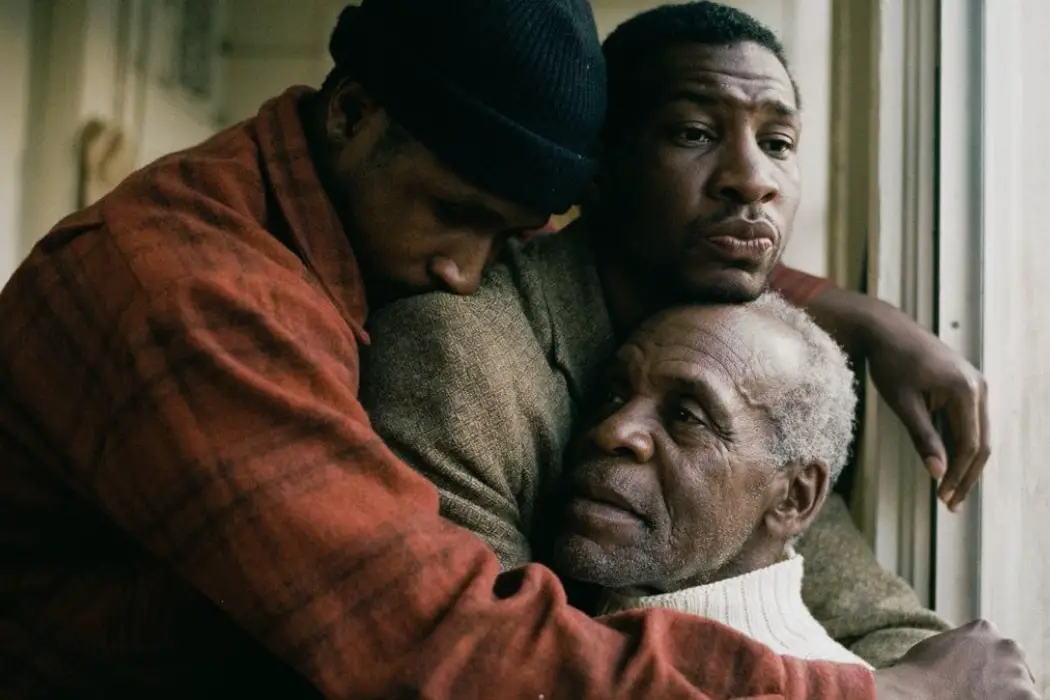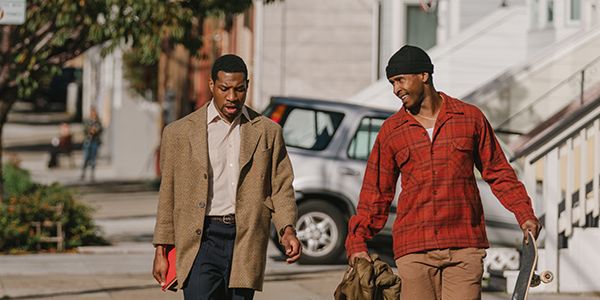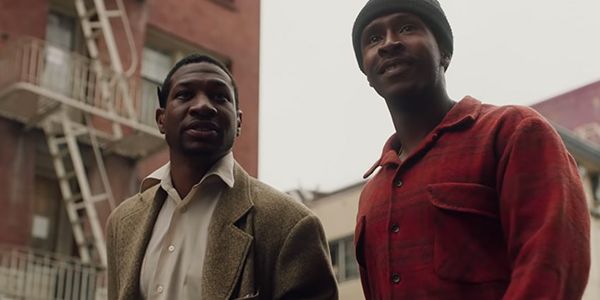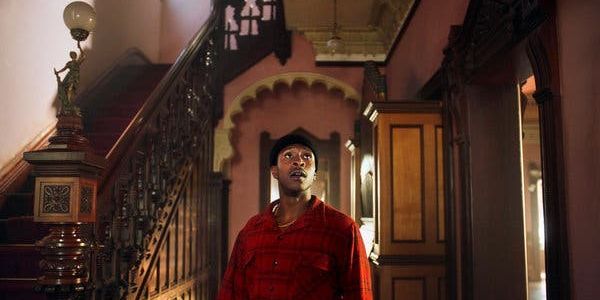The Musical Roots of THE LAST BLACK MAN IN SAN FRANCISCO

Andrew Emerson is a University of Chicago student. His high…
Joe Talbot’s The Last Black Man in San Francisco tells the story of Jimmie (Jimmie Fails) and Montgomery (Jonathan Majors), two black friends who live in San Francisco. Put simply, the film follows Jimmie’s attempts to reclaim a house in San Francisco’s historic Fillmore District. (For brevity’s sake, I’ll refer to this house as “the Fillmore house” for the rest of this article.) Although Jimmie and his family owned the house in the past, they were forced to move out as a result of gentrification. Despite this, however, Jimmie continues to believe that the house rightfully belongs to him, claiming that his grandfather built it “with his own hands” in the middle of the 20th century.
In this article, I’m going to argue that The Last Black Man in San Francisco shares important similarities with musicals. Granted, that idea might seem completely nonsensical. One essential part of the definition of a movie musical, after all, is that the characters sing. Yet, with just a couple of exceptions – at one point, for instance, a street musician sings a cover of Scott McKenzie’s “San Francisco” – the characters in The Last Black Man in San Francisco don’t sing at all. To put it another way, the music we hear in The Last Black Man in San Francisco is usually Emile Mosseri’s score, which, unlike songs in musicals, remains non-diegetic throughout the film.
Musical Interludes
Even if it isn’t actually a musical, however, The Last Black Man in San Francisco uses its soundtrack in a way that’s quite similar to how musicals use songs. To begin with, songs in musicals typically aren’t primarily interested in “advancing” the plot. As illustrated by films like La La Land and Singin’ in the Rain, in other words, characters in musicals usually don’t sing in order to overcome obstacles or reach objectives. Rather, songs are designed to emphasize an emotional moment, elaborating on sentiments that could otherwise be quickly communicated through one or two lines of dialogue.

In keeping with this idea that songs don’t advance the plot, The Last Black Man in San Francisco contains several instances of what you could call “musical interludes.” These are sequences that are characterized by two things. First, they prominently feature background music. Second, nothing much “happens” plotwise: typically, these sequences simply depict Jimmie as he skateboards from one place to the next.
Here’s one example of what these musical interludes look like in practice. Early in the film, there’s a sequence in which Jimmie and Montgomery skateboard to the Fillmore house. Since this sequence depicts the two while they’re in a “state of transit,” it would’ve lasted only a few seconds in a traditional narrative film. But in The Last Black Man in San Francisco, it instead becomes an extended, slow-motion montage of the many sights and people that the two men see en route. Most importantly, the whole sequence is set to inspiring-sounding music, and the implication is that said music conveys the pride and joy that the two men feel upon viewing these sights and people.
In effect, this and other interludes in The Last Black Man in San Francisco serve the same function that songs do in musicals. In a sense, it’s as though the movie were taking a “pause” – and concurrently allowing the soundtrack to “come in” and offer a detailed, expressive illustration of Jimmie’s feelings. Just as songs in musicals illustrate emotions at the expense of narrative development, in other words, narrative development takes a back seat in these interludes to the score’s attempts to evoke emotion.
Music As Escape
Interludes aside, however, the biggest similarity between The Last Black Man in San Francisco and musicals is the antagonistic relationship that they both establish between music and reality. In musicals, after all, songs frequently represent both a style and content-based “escape” from the grim, brutal reality of the surrounding narrative. Stylistically, this dichotomy between dreams and reality is readily conveyed through the numerous inherent differences between musical numbers and non-musical narrative. In terms of content, moreover, characters in musicals often use songs to express deep-seated desires and fantasies that the music-free “real world” fails to honor or acknowledge (for examples of this, see films like Les Misérables, Chicago, Mulan, and The Little Mermaid).

Strikingly, just as songs in musicals constitute an escape from brutal reality, the score in The Last Black Man in San Francisco invariably plays before and after moments of struggle, sadness, or tragedy in the narrative. For instance, the aforementioned opening interlude is preceded by a scene in which men in hazmat suits clean up a contaminated body of water near Jimmie’s neighborhood. Elsewhere, music bookends scenes in which Jimmie and Montgomery learn about the shooting of a neighbor, face insults from white people, and permanently part ways.
If my memory serves me well, there’s one scene in The Last Black Man in San Francisco that does a particularly good job of representing the function of music in the overall film. In said scene, Jimmie explains to a skeptical tour guide that the Fillmore house was built by Jimmie’s grandfather in the 1940s – not, as the tour guide claims, by some white guy in the 19th century. Importantly, as Jimmie begins to explain this, uplifting music starts playing in the background.
Towards the end of the film, we learn that the Fillmore house wasn’t built by Jimmie’s grandfather – and that Jimmie actually knew this all along. Given this, the music’s presence in this scene can be read as an indicator that Jimmie is indulging a fantasy. Just as songs in musicals represent characters’ escapist fantasies, in other words, the music in this scene suggests that Jimmie’s speech is a consciously created illusion, a comfortable lie that he creates in order to avoid confronting the truth about his family history.
Closing Thoughts
At this point, these similarities between The Last Black Man in San Francisco and traditional musicals might seem either coincidental or meaningless. But they gain significance when you recall what musicals are. As alluded to earlier, musicals often feature narratives that are about the tension between dreams and reality. (For examples of this, see La La Land and The Umbrellas of Cherbourg.) In a sense, the conventions that we have discussed – songs that “pause” the narrative to develop emotions, songs that represent “escape” – are examples of techniques that traditional musicals use to develop this narrative theme.

If you keep this in mind, you can better understand the “point” of The Last Black Man in San Francisco’s similarities to musicals. As mentioned earlier, The Last Black Man in San Francisco is about the tension between dreams and reality – or, to be more specific, a man who has to let go of an illusion that doesn’t reflect reality. In order to draw our attention to this theme, moreover, The Last Black Man in San Francisco uses the conventions of the musical, a genre that it doesn’t actually belong to, because the musical is characterized by its interest in this theme.
In this way, The Last Black Man in San Francisco proves to be quite subversive. It not only demonstrates a keen understanding of genres and the tropes that we tend to associate with each of them. More significantly, the film also plays with this understanding: as a non-musical that adopts musical conventions, it knowingly flouts the boundaries that traditionally separate musicals from other genres. Ultimately, this perceptive blending of genres is a big reason why The Last Black Man in San Francisco proves such a memorable and exhilarating experience.
Do you agree with me? Why or why not? Please share your thoughts in the comments!
Does content like this matter to you?
Become a Member and support film journalism. Unlock access to all of Film Inquiry`s great articles. Join a community of like-minded readers who are passionate about cinema - get access to our private members Network, give back to independent filmmakers, and more.
Andrew Emerson is a University of Chicago student. His high school English teacher once asked him to read a batch of Roger Ebert’s reviews for class, and he’s been fixated on the idea of writing about movies ever since. You can follow his attempts to pursue this obsession at http://filmwatcher.net/.













